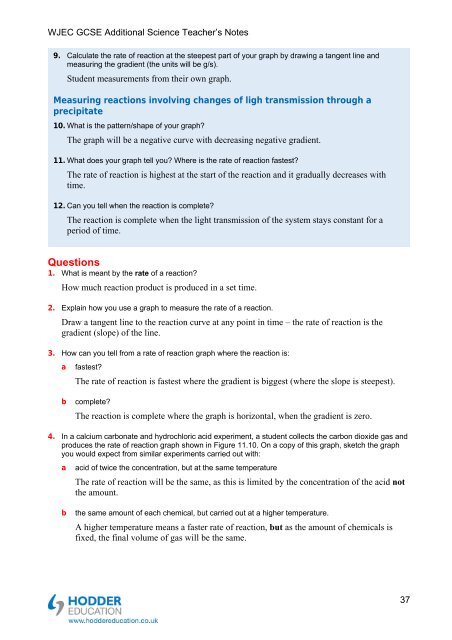Teacher's notes and answers to questions in the book - Hodder Plus ...
Teacher's notes and answers to questions in the book - Hodder Plus ...
Teacher's notes and answers to questions in the book - Hodder Plus ...
You also want an ePaper? Increase the reach of your titles
YUMPU automatically turns print PDFs into web optimized ePapers that Google loves.
WJEC GCSE Additional Science Teacher’s Notes<br />
9. Calculate <strong>the</strong> rate of reaction at <strong>the</strong> steepest part of your graph by draw<strong>in</strong>g a tangent l<strong>in</strong>e <strong>and</strong><br />
measur<strong>in</strong>g <strong>the</strong> gradient (<strong>the</strong> units will be g/s).<br />
Student measurements from <strong>the</strong>ir own graph.<br />
Measur<strong>in</strong>g reactions <strong>in</strong>volv<strong>in</strong>g changes of ligh transmission through a<br />
precipitate<br />
10. What is <strong>the</strong> pattern/shape of your graph<br />
The graph will be a negative curve with decreas<strong>in</strong>g negative gradient.<br />
11. What does your graph tell you Where is <strong>the</strong> rate of reaction fastest<br />
The rate of reaction is highest at <strong>the</strong> start of <strong>the</strong> reaction <strong>and</strong> it gradually decreases with<br />
time.<br />
12. Can you tell when <strong>the</strong> reaction is complete<br />
The reaction is complete when <strong>the</strong> light transmission of <strong>the</strong> system stays constant for a<br />
period of time.<br />
Questions<br />
1. What is meant by <strong>the</strong> rate of a reaction<br />
How much reaction product is produced <strong>in</strong> a set time.<br />
2. Expla<strong>in</strong> how you use a graph <strong>to</strong> measure <strong>the</strong> rate of a reaction.<br />
Draw a tangent l<strong>in</strong>e <strong>to</strong> <strong>the</strong> reaction curve at any po<strong>in</strong>t <strong>in</strong> time – <strong>the</strong> rate of reaction is <strong>the</strong><br />
gradient (slope) of <strong>the</strong> l<strong>in</strong>e.<br />
3. How can you tell from a rate of reaction graph where <strong>the</strong> reaction is:<br />
a fastest<br />
The rate of reaction is fastest where <strong>the</strong> gradient is biggest (where <strong>the</strong> slope is steepest).<br />
b complete<br />
The reaction is complete where <strong>the</strong> graph is horizontal, when <strong>the</strong> gradient is zero.<br />
4. In a calcium carbonate <strong>and</strong> hydrochloric acid experiment, a student collects <strong>the</strong> carbon dioxide gas <strong>and</strong><br />
produces <strong>the</strong> rate of reaction graph shown <strong>in</strong> Figure 11.10. On a copy of this graph, sketch <strong>the</strong> graph<br />
you would expect from similar experiments carried out with:<br />
a acid of twice <strong>the</strong> concentration, but at <strong>the</strong> same temperature<br />
The rate of reaction will be <strong>the</strong> same, as this is limited by <strong>the</strong> concentration of <strong>the</strong> acid not<br />
<strong>the</strong> amount.<br />
b <strong>the</strong> same amount of each chemical, but carried out at a higher temperature.<br />
A higher temperature means a faster rate of reaction, but as <strong>the</strong> amount of chemicals is<br />
fixed, <strong>the</strong> f<strong>in</strong>al volume of gas will be <strong>the</strong> same.<br />
37

















